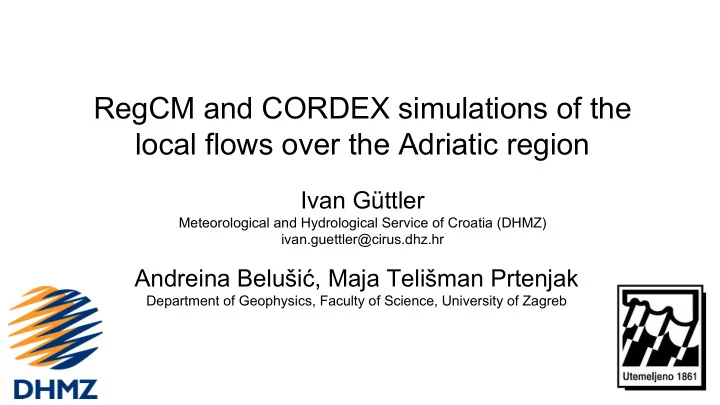

RegCM and CORDEX simulations of the local flows over the Adriatic region Ivan Güttler Meteorological and Hydrological Service of Croatia (DHMZ) ivan.guettler@cirus.dhz.hr Andreina Belušić, Maja Telišman Prtenjak Department of Geophysics, Faculty of Science, University of Zagreb
Bora/Bura Sirocco/Jugo
Belušić A, M Telišman Prtenjak, I Güttler, N Ban, D Leutwyler, C Schär, 2017: Near-surface wind variability over the broader Adriatic region: insights from an ensemble of regional climate models. Clim. Dyn., DOI : 10.1007/s00382-017-3885-5
7 EURO-CORDEX simulations 3 Med-CORDEX simulations 2 ETHZ simulations ERA-Interim Station observations QuikSCAT observations Daily and subdaily wind speeds Period: 1996/2001-2008
DJF 10m wind speed JJA 10m wind speed
Open-sea and inland locations: Bias, RMSD, Corr. Coeff. Coastal locations: Bias, RMSD, Corr. Coeff. 0.11°/12.5km simulations, 0.02° ETHZ-CLM, ERA-Interim
Taylor diagram: Middle South Adriatic and Zagreb Taylor diagram: Zadar and Senj stations 0.11°/12.5km simulations, 0.02° ETHZ-CLM, ERA-Interim Bilinear vs. NN interpolation.
Power Spectral Distribution (m 2 /s 2 ) Observations vs. DHMZ-RegCM42-11 SMHI-RCA4-11 ETHZ-CCLM-11 ETHZ-CCLM-02
Belušić, A, I Güttler, B Ahrens, A Obermann-Hellhund, M Telišman Prtenjak, 2018: Wind over the Adriatic Region in CORDEX Climate Change Scenarios, in revision
0.11°/12.5km RCMs GCM boundary conditions
QQ plot: 2001-2005; daily time-scale; 4 locations
DJF ensemble median and corresponding IQR (second row) of 99th percentile of wind speed in RCP8.5 scenario. The ensemble consists of 19 members, except for P3 which has 15 members. Relative differences for P1 (a, d), P2 (b, e) and P3 (c, f) compared to P0.
JJA ensemble median and corresponding IQR (second row) of 99th percentile of wind speed in RCP8.5 scenario. The ensemble consists of 19 members, except for P3 which has 15 members. Relative differences for P1 (a, d), P2 (b, e) and P3 (c, f) compared to P0.
Relative changes (P2/P0-1) in P2 compared to P0 in frequencies of the wind blowing from NNE to ENE direction (upper triangle) and from ESE to SSE (lower triangle). Red color indicates the increase in frequency, while blue indicates the reduction in frequency. Table under each matrix contains number of RCM simulations that shows reduction in NNE-ENE/ESE-SSE flow frequencies (NoS ≤ −1%), no change in frequencies (−1% < NoS < 1%) and an increase in frequencies (NoS ≥ 1%). NoS stands for “number of simulations with specific relative change”. The results are for RCP8.5 scenario.
Thank you for your attention! Acknowledgements Croatian Science Foundation (HrZZ) projects CARE (no. 2831) and VITCLIC (PKP-2016-06-2975). Swiss National Science Foundation through the Sinergia grant CRSII2_154486 ‘crCLIM’. CORDEX group members for providing useful information. World Climate Research Programme’s Working Group on Regional Climate and, Working Group on Coupled Modelling, the former coordinating body of CORDEX and the responsible panel for CMIP5. Med-CORDEX database (http://www.medcordex.eu). ECMWF MARS database (http://www.ecmwf.int). NOAA’s National Climatic Data Center (http://www.ncdc.noaa.gov), DHMZ database and Crocontrol database. European Union's Horizon 2020 research and innovation programme under the grant agreement n° 653824/EU-CIRCLE. „ Strengthening the Capacity of the Ministry of Environment and Energy for Climate Change Adaptation and development of the Draft Strategy for Climate Change Adaptation (Contract number: TF/HR/P3-M1- O1-010) ” project funded by the EU Transition Facility.
Recommend
More recommend